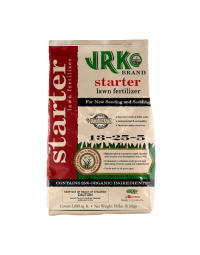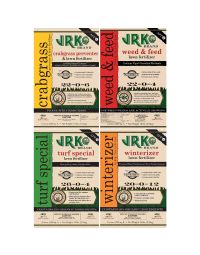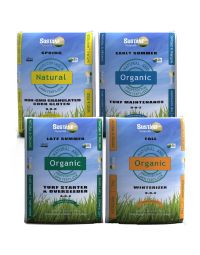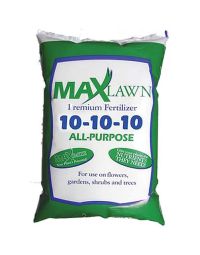Step 1. Mow Lawn Short
Mow you grass to a height of 1.5" to 2"
Step 2. Rake Area Thoroughly
Use an overseeder rake or leaf rake taking care not to rip out existing grass. Till the soil 6 inches for good root development if the soil is heavy clay, then till in top dress soil in the upper surface to loosen compaction and for good root development.
Step 3. Aerate & Dethatch Your Lawn
Aerate stressed lawns to encourage good root development before the upcoming winter. Aeration helps loosen compacted soil and create a better grass growing environment. Aerating and de-thatching are best done when a lawn can take some abuse and recover easily. Fall is perfect due to the cool air temperatures and warm soil temperatures. Dethatching and aerating should be done before over-seeding to ensure the seed makes direct contact with the soil. Homeowners and landscapers can now rent from a large selection of machines that have attachments for de-thatching, spike aeration, and core aeration (for very compact soils with low water drainage). Using Natural Guard Soil Activator is a good way to naturally help the thatch in your yard break down. If there is excess thatch present, use a dethatching rake to eliminate the dead matter.
Step 4. Broadcast Starter Fertilizer
Use Starter Fertilizer for optimum seed germination and quick establishment. Rake Starter Fertilizer in the soil for faster root development on the grass seedlings. Level the soil to proper grade. Do the step test-if your shoe sinks in 1/2 inch, the soil is too soft to seed. Press the soil gently with a lawn roller without water.
Step 5. Broadcast Seed Over Lawn
Autumn is the best time of year to seed lawns. Newly germinated grass seedlings have a greater chance of survival in the cooler season. We have a grass seed mix that will fit your needs. Use a hand spreader for smaller areas and a larger broadcast spreader for larger lawns. For a more even spread, apply half in one direction and the other half in the other direction. Broadcast your seed 1/2 rate North to South and remaining 1/2 East to West.
Step 6. Rake Seed In
Rake with a leaf rake to ensure good seed to soil contact, lightly less than 1/4 of a inch with a wire leaf rake into the soil. Use the back end of a rake to press the seed down to avoid wash out from water run-off.
Step 7. Watering
Water on a regular schedule to make sure seed and soil stay moist. Water the seeded area frequently, water seeded area almost dry time to water again. The seeded area should kept moist for 4-6 weeks. Sunny locations and dry weather will require you to water more frequently. Using a timer will help you achieve an even growing environment.
EXTRA ADVICE
If you have irregular patches or your turf grass easily rolls back when pulled, moles are most likely the issue. Consider adding a grub control product. Apply with a spreader then water in with a sprinkler. The moles will leave in search of a better food source after you rid your grass of the grubs.
After over-seeding, fertilizing will give the seed an extra boost and help the existing lawn thrive through autumn. JRK Turf Special is perfect for autumn fertilizing. Be sure that the seed is also getting enough water during the fall months. A thirsty lawn is a sad lawn. Fertilizing in late October builds energy in the grass root systems, forcing grass plants to push new roots and rhizomes. This process thickens your lawn and helps build deep roots along with reserves that help your lawn combat next summer's heat stress. Good roots make a great lawn. In the late fall, JRK Winterizer should be used to ensure that the work done this fall will show next spring.
Organic Options
If you’re looking to go organic, we have a selection of organic fertilizers including Milorganite, Sustane and Espoma.






